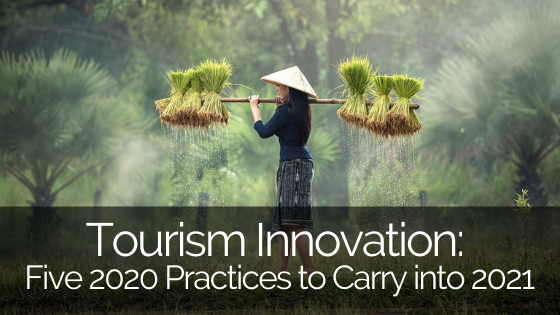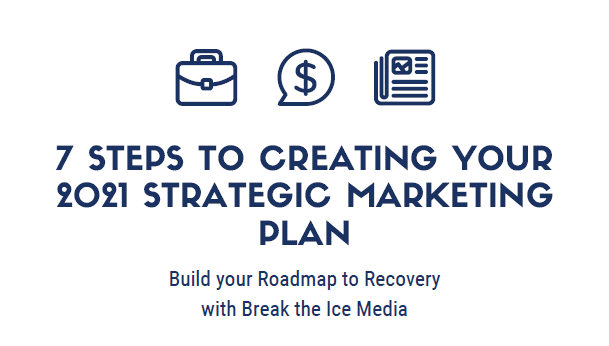Tourism Innovation: Five 2020 Practices to Carry into 2021
Let’s not let the last 12 months go to waste. It may seem hard to find but, I know there was a lot of good that came out of last year. As we start 2021, these are five things that the travel, tourism and hospitality industry can take forward with us to continue the tourism innovation we found in 2020.

Growth Mindset
In March 2020, it was hard to imagine what the rest of the year would be like with our “normal” lives abruptly disrupted and uncertainty around what would happen next. However, what we saw around our industry was a resiliency to the challenges. We saw quick moves to new ways of working, different ways to deliver our goods or services and changes in our focus.
As the year went on and the uncertainty and challenges lingered, we heard from organizations in the industry that they found better, more efficient ways to accommodate guests, serve customers and market their destinations. Suddenly local businesses found new local or regional customers and many reported they had a best month, quarter or year in 2020 despite the pandemic.
“no matter what your ability is, effort is what ignites that ability and turns it into accomplishment.”
Carol Dweck, Mindset: A New Psychology of Success
What enabled these organizations and businesses to not only survive 2020 but thrive despite the challenges?
I believe it was the organization’s commitment to a growth mindset. When you adopt a growth mindset, you view everything as an opportunity to learn, grow and expand. Versus those who adopt a fixed mindset which believe, they only have a set amount of capabilities, can only operate in a certain way and challenges stop them in their tracks.
Growth-minded organizations see roadblocks as an opportunity to change for the better. In the book Mindset: A New Psychology of Success, Carol S. Dweck shares her research on the differences between a growth mindset and a fixed mindset and how that applies to all aspects of life: parenting, business, school, relationships. In her book she proves “people have more capacity for lifelong learning and brain development than they ever thought.” 2020 proved that! Our industry was challenged more than any other industry and we met that challenge, not without pain or stress, but we rose to the occasion.
Growth mindset is one we should hold onto for the future because as Carol Dweck reports in her book, “no matter what your ability is, effort is what ignites that ability and turns it into accomplishment.”
Innovation
Companies who kept a growth mindset during challenging times were able to re-imagine how the world does business. There are many examples we can draw on in our past that prove innovation is born during uncertain times. The sharing economy was created as a new game plan after the 2008 global financial crisis, to stimulate the economy by creating new models of business. Today, companies like Uber, Lyft and Air B &B are commonplace and just think about how they changed our world.
Imagination
Martin Reeves and Jack Fuller, both part of the Boston Consulting Group’s Henderson Institute, wrote a brilliant article entitled “We Need Imagination Now More Than Ever,” published by the Harvard Business Review on April 10, 2020. Reeves and Fuller put forth the argument that imagination — in the face of uncertainty, economic crisis, and the historic challenges we are facing right now — is exactly what we need to solve the problem.
The authors believe – and I agree – “that your capacity to imagine…to create, to evolve, and to pursue ideas — is a crucial factor in seizing and creating new opportunities and finding new paths to growth.”
Companies that are able to innovate under pressure reap significant value. In recessions and downturns, 14% of companies outperform their competitors because they invest in new growth areas.
For example, Apple released its first iPod in 2001 — the same year the U.S. economy experienced a recession that contributed to a 33 percent drop in Apple’s total revenue. Still – Apple saw the iPod’s ability to transform its product portfolio so the company increased R&D spending by double digits, which sparked an era of high growth for the company.
Tourism innovation should not stop after 2020, we need to carry this practice forward. You are part of the new normal, you are the leaders, the visionaries, the great thinkers that will help define our industry for the next generation.
Collaboration
We are all in this together, that could be the mantra of 2020. During the last 12 months we saw organizations and associations across our industry step up in new ways providing a platform for sharing experiences and ideas for navigating the “new normal.” We saw businesses and organizations collaborating in new ways, from centralized outdoor dining to municipalities changing codes and restrictions to creative marketing ideas between organizations. We found out just how important collaborations really are.
If we learned only one thing from the global pandemic, we are all in this together, our world is interconnected and we must work together to create our new reality, the travel, tourism and hospitality industry of the future. The answer is to respond together, to break down the siloes and operate in “co-opetition” (cooperating competition). To achieve a new normal that keeps the travel industry not only alive, but thriving, we need to master the art of world-changing collaborations.
For more ideas on how to build a successful collaboration see our 3-part blog series:
[display-posts id=”16081, 16118, 16129″ image_size=”medium” include_title=”false” wrapper=”div” align=”center”]
Do more with less
In 2020, we learned to do more with less. Less travel, lower budgets, less staff, fewer customers, less face-to-face interaction, the list goes on. An interesting thing happened though, we learned how to get by with less. We were forced to make hard decisions about expenses, budgets and staff. Decisions we may have been putting off or ignoring were now imperative to our ability to keep going. We needed to find more efficient ways to work, produce our products or services and reach our customers.
Those organizations that got laser-focused the quickest and stayed in the growth mindset saw better results than those who were stuck in the fixed mindset.
- One winery told us they had fewer visitors to their tasting room but higher revenues. That’s because the customers who did come in had more access to the winery, which created more opportunities for them to make purchases.
- A re-imagined outdoor winter experience helped one museum triple revenue and attendance in December compared to the same month in 2019.
- Many destinations located near large outdoor experiences, state and national parks saw high occupancy numbers throughout summer 2020.
- And a destination in the South reported their occupancy had rebounded so strongly after the initial shutdowns that they had almost recovered fully on average occupancy rates for the whole year even without the return of the business traveler.
All of this achieved with less! We have found having a laser-focused strategy and a plan help you do more with less. That is something we want to carry into 2021.

Download our 7 Steps to Creating Your 2021 Strategic Marketing Plan infographic here:
Slower pace
The shutdowns and restrictions on travel created a much slower pace for most of us. With the slower pace came an opportunity to enjoy the simpler things in life and to find new passions. Many of us enjoyed family time, made room for exercise, learned a new skill or joined an online class. Others read more books, got outdoors or made time and space for reflection and personal development.
Whatever you did with the slower pace, my hope is you will carry it forward into 2021 and beyond. Being more intentional and focused on what matters is the best gift from 2020!
For more on the importance of leading yourself first, listen to Destination on the Left Episode 210 with Tammy Blount-Canavan, you will be inspired!
Author
Related Posts
Communication: The 3 C’s of World-Changing Collaborations
Big ideas and big achievements don’t happen alone. They require teamwork and a shared goal. That’s why collaboration is essential, especially in the travel and…
Building Belonging in Tourism Marketing
The days of relying on glossy brochures and catchy taglines to attract travelers are behind us. Today, what truly resonates with visitors isn’t a brand’s…
